The following thoughts contain minor spoilers for Keep on the Shadowfell. If you don’t want to be spoiled, don’t read it. And if you’re in my gaming group then you definitely shouldn’t be reading it.
A4. THE DRAGON BURIAL SITE
This encounter will largely play out in the same way, but we’re going to change the nature of the artifact (to have it tie directly into Kalarel’s ritual) and expand the information Douven Stahl has to impart.
THE ARTIFACT: The artifact they’ve dug up is a small stone idol of Orcus. It can recognized on a successful Religion check (DC 15).
DOUVEN STAHL: Douven Stahl can tell them everything on pg. 210 of the Monster Manual regarding the cults of Orcus. Then he will continue with a description of local cult activity:
“Two hundred years ago, this entire region south of the Cairngorms was a stronghold of the cult. The cult deliberately created a gap between this world and another realm – the Shadowfell. Although not inherently evil, the Shadowfell is fraught with dangers, and through the gap between worlds the cult brought forth skeletons, zombies, and even fouler creatures.
In those days, fortunately, the Empire of Nerath was still strong. A legion was dispatched to quell the threat. They destroyed the undead, sealed the rift, and built a keep to keep watch over the location and contain the threat. Today, however, that keep lies in ruins.
I came here merely to study history. But now I fear that the cult has returned, and seeks to open that gap between worlds once again. If that were to happen… without the Empire to respond…” He shudders.
If asked, Stahl can also tell them about the ritual:
“The worship or Orcus revolves around the practice of human sacrifice. But these sacrifices are not merely about death, they about the collection and distribution of a victim’s blood. Cult rituals often revolve around filling a skull with blood, drinking it, and then filling it again for Orcus and pouring it over his idol.
If these cultists are trying to reopen a portal to the Shadowfell, then they must be attempting to tap into the ancient magic that first created the gap between worlds. There will be a sacrifice of blood and an idol of Orcus.”
If Stahl is shown the Orcus idol:
“This is an ancient idol, but you can see by the markings along its base that it is merely part of a larger set. When brought together, these multiple idols intensify each other’s power. By capturing this idol, you will have delayed whatever ritual they’re preparing for… but not prevented it.”
FOLLOW-UP: Douven Stahl will return to Winterhaven and lodge up with Valthrun. He can be found in Valthrun’s tower if the PCs need to ask him further questions.
THE KEEP – AREA 18
CRUCIFIED ANGEL: Hanging above the altar in this area is an angel of protection (Monster Manual, pg. 14). It has been pinioned to the wall with multiple adamantine spears. A wall of arcane magic surrounds the angel and can only be penetrated if the ritual in Area 19 is disrupted.
ANGEL’S BLOOD: Blood flows from the angel’s wounds, over the Orcus-pledged altar, through the wall of arcane magic, and down into the pit below. Corrupted by the mystic energies of the altar, it is serving as a crucial material component for Kalarel’s Ritual.
THE KEEP – AREA 19
THE FANE OF ORCUS: The pit in the center of this room is, in fact, 60 feet deep. Standing in this pit is a 60′ tall statue of Orcus the Demon Prince. This is the Fane of Orcus. Through the fane, Orcus is able to manifest some portion of his will upon this world. It is an important part of Kalarel’s Ritual.
THE IDOLS OF ORCUS: The four grates depicted on the map are, instead, sunken depressions in the floor. In two of them, the Idols of Orcus have been placed. (If the PCs failed to disrupt the activities at the Dragon Burial Site, three of them will be occupied.) Blood flows up out of the pit and towards these depressions. (See Kalarel’s Ritual.)
KALAREL’S RITUAL
Level: 25
Category: Travel
Time: 120 days
Duration: Permanent
Component Cost: Special
Market Price: n/a
Key Skill: Religion
Kalarel’s ritual will open a permanent connection between this world and the Shadowfell. Once the ritual is one-quarter completed, the Thing in the Portal manifests (see module).
Special: Kalarel is able to perform a ritual so far above his normal level because this specific ritual is bound to the Fane of Orcus.
The smaller Idols of Orcus are also being used to help focus the ritual, reducing the amount of time necessary. Each idol added to the ritual reduces the remaining time of the ritual by half.
TIMELINE
When the PCs first arrive in the valley, 30 days have passed since Kalarel started his ritual. Kalarel had also already recovered two of the Idols of Orcus, reducing the remaining time for the ritual to be completed to 45 days.
If the PCs don’t interfere with Kalarel retrieving the Idol of Orcus from the Dragon Burial Site, it will be installed and whatever time remains will be further reduced by half.
REVERSING THE RITUAL
Kalarel is working from a reconstructed and partially translated text known as the Scrolls of Hamasatra. This text is located atop the altar in Area 19 of the keep. The skill challenge for reversing the ritual is based, in part, on an article available at WotC’s website.
Level: 6th
Complexity: 3 (8 successes before 4 failures)
Primary Skills:
Arcana (DC 22): As a standard action, you can call upon your knowledge of magical effects and rituals to study the ritual book and determine the next step in unbinding the ritual. The first successful Arcana check also allows the character to figure out how a Heal check can contribute to undoing the ritual. A failed check indicates that the energy of the ritual attacks you: +10 vs. Will; 1d6 + 4 necrotic damage.
Endurance (DC 18): As an opportunity action, triggered when an adjacent ally has just failed an Arcana or Religion check to reverse the ritual, you can allow the necrotic energy flowing through the ritual to damage you instead of your ally. Success at this skill use aids the party, but does not count as a success toward completion of the challenge.
Heal (DC 18): As a standard action, you can make a Heal check and spend a healing surge to send positive life energy into the necrotic ritual in order to help disrupt it. In doing so, you automatically expose yourself to the energy of the ritual, which attacks you: +10 vs. Will; 1d6 + 4 necrotic damage. This approach to undoing the ritual can be determined on any successful Arcana, Religion, or Insight check.
Insight (DC 18): A character succeeding at an Insight check as a free action, triggered by observing the ritual, can figure out how a Heal check can contribute to undoing the ritual. Success at this skill use aids the party, but does not count as a success toward completion of the challenge.
Religion (DC 22): As per the Arcana check.
Success: The ritual is undone. The angel in area 18 is freed, but collapses into unconsciousness. (However, nothing stops Kalarel from starting the ritual afresh. If the Scrolls of Hamasatra are destroyed or the angel escapes or Kalarel is killed, however, the threat has passed. In that case, reward the adventurers a major quest reward of 750 XP.)
Failure: If the skill challenge is failed, the magical energy of the Shadow Rift stabilizes. Necrotic energy surges through the ritual book and the altar, striking all of the characters attempting this skill challenge. Each of these characters loses a healing surge and is attacked by the necrotic energy: +10 vs. Will; 1d6 + 4 necrotic energy.
The ritual isn’t complete, but the partially opened rift remains as such until either Kalarel is killed or the ritual is completed.

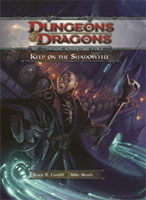
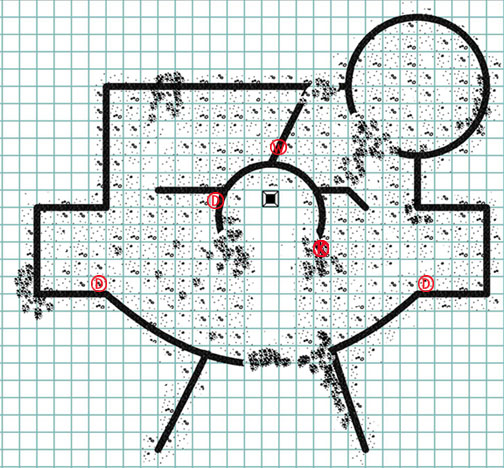
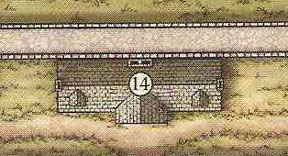
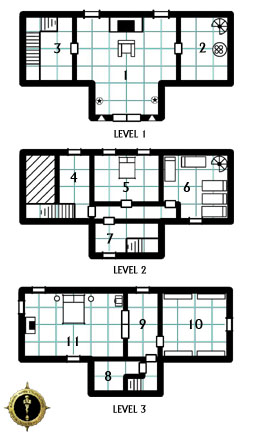 DOORS: The outer doors are barred from the inside (Break DC 20). The interior doors are not initially locked, although they can be if the cultists decide they need to barricade themselves (Break DC 16, Thievery DC 20).
DOORS: The outer doors are barred from the inside (Break DC 20). The interior doors are not initially locked, although they can be if the cultists decide they need to barricade themselves (Break DC 16, Thievery DC 20).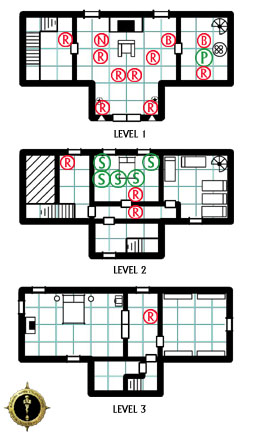 CULTISTS:
CULTISTS:









